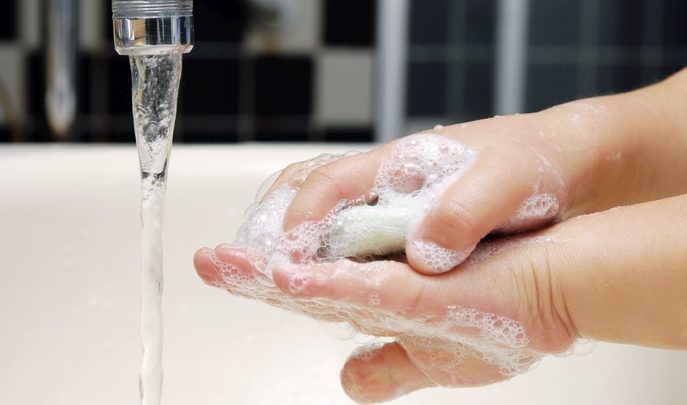After The Mess Is Done – How To Teach Your Children Good Hygiene Habits

Encouraging kids to clean their mucky fingers after messy play and other grubby activities takes commitment, but it’s vital that we make the effort, says Wendy Bowkett…

I don’t have OCD, but I am a tad fanatical about good hygiene – especially in the context of working with young children.
When I first started teaching, there were no temperature controls on hot water, unlike nowadays. We taught children to place the plug in the sink first, pour in some cold water and then turn on the hot tap gently, testing the temperature of the water in the sink constantly until it felt comfortable to wash hands in. Tablets of soap were the norm, not press-down squirty liquid.
The process took a while, so the soap soon became slithers of soggy, slippery mush – but the children’s hands, when rinsed in fresh water after washing, were very clean.
Dirty marks
During the early 90s a law was introduced to ensure that in schools, no hot tap actually had hot water coming out of it: 38 to 43° was the hottest temperature allowed. Soon, children began turning on the hot tap and just putting their hands under the flowing, tepid water, ignoring the bar of soap. They thought they didn’t need to put the plug into the sink and test the water any more, because the ‘hot’ water was always the right temperature.
It seemed to them that a little spot of liquid soap, rubbed on their hands under the water to wash off the bubbles, would make for clean hands. They would leave the bathroom quite happily with clean palms, yet paint was still between their fingers and on the backs of their hands, with marks left on their own towels.
We had assumed that the children would carry on washing their hands as effectively as before. We were wrong. Although each child’s towel was changed several times each session, we noticed that some children were using other children’s towels because they had left dirty marks on their own.
Even with increased supervision in the bathroom area and a change to paper towels for hygiene reasons, some children would use one they found on the floor or share one with a friend while they had a chat. We had our work cut out to help them understand how important hand-washing was to keep us healthy.
We chatted with the children about the reasons for washing our hands – to remove germs that could make us ill. They learnt that practising good personal hygiene, especially before and after handling our nursery pets, eating food and after using the toilet or a potty, was important if they were to stay healthy. We had little pictures on the rabbit and guinea pig pens, boxes of tissues and toilet doors to help the children remember to wash their hands.
A thoroughly grubby time
There was quite a bit to do to encourage them at first, but as they became familiar with the routine, it became second nature for most. To emphasise the importance of clean hands, each member of staff did something messy or dirty over the course of the week to show children how we washed our hands to remove germs and bacteria.
We fingerpainted, played with clay, made cornflour paste patterns, planted some seeds and flowers in the garden, cleaned out the hen house and had a thoroughly grubby time.
Afterwards, we showed the children steps to having clean hands:
• Wet hands all over with warm water and add a spot of liquid soap on a palm
• Away from the running water, rub hands together, rub fingers and thumbs and the bits in between
• Rub nails on palms, and palms on the back of each hand
• Use a nail brush after gardening or messy play, or with stubborn paint
• Put hands back under clean, flowing water and rinse
• Dry really well with paper towels – which must only but used once!
During the week, we also made up a chant while washing our hands:
Wet your hands with water, add a drop of soap. Rub your hands together; fingers, thumbs and gaps. Rub your nails on each palm, rub the backs of hands. Rinse them under water and dry with a towel.
With some of our younger children (those under 30 months) we used a simple version of the finger rhyme ‘Here’s a church…’ to get across the idea of washing between their fingers. The ‘people’ then rubbed the backs of their hands to clean the church and their nails to clean the windows. It was time-consuming, but well worth the effort!
Wendy Bowkett is an early years practitioner with over 30 years’ experience and the author of a number of books aimed at professionals working with 0 to 5-year-olds











